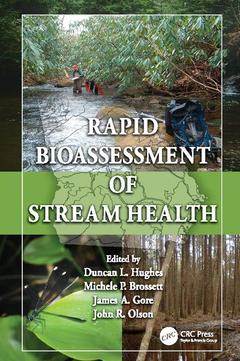Rapid Bioassessment of Stream Health
Auteurs : Hughes Duncan L., Gore James, Brossett Michele P., Olson John R.

Tasked by the Clean Water Act to restore and maintain the integrity of their waters, state and local governments must develop systems for assessing the health of the streams within their borders. They quickly find that one size does not fit all when it comes to sampling. Rapid Bioassessment of Stream Health examines the sampling techniques, laboratory methods, and data analysis necessary to create a protocol for analyzing the health of streams, using rapid bioassessment techniques.
The editors explore how to determine reference streams in each ecoregion and subecoregion with specific indices of health. They provide field methods for monitoring and sampling invertebrates and laboratory methods for subsampling. The work focuses on the application of the EPA?s Rapid Bioassessment Protocol (RBP) but suggests various techniques that can be used to improve sampling protocols and quality control, where necessary. It also includes general listings of health classifications, appendices of more than 300 streams that have been sampled, and a GIS method for designating the reference condition for purposes of comparison in each ecological unit.
Although the EPA?s RBP Manual is considered to be the standard of information on the types of metrics that can be used, this book explores, from a state regulatory standpoint, the practical development of such a system to begin compliance with critical sections of the Clean Water Act. A compendium of information about prioritizing those streams and small rivers requiring analysis, this book contains guidelines on the assessment of streams in a particular ecoregion and sampling streams that are at least impaired as points of comparison. It supplies guidance for the production of other rapid bioassessment tools customized to various ecoregions and subecoregions.
Introduction. Reference Conditions: Selection of Regional Reference Sites. Assessing Impact Using the Synoptic Approach. Data Sources and Preprocessing. Field and Laboratory Methods. Data Analysis. An Unbiased Approach to Creating Reference Conditions. Biotic Index Development. The Numerical Ranking System. Fixed-Count Subsampling and Bootstrap Resampling: An Evaluation. Is the Representative Stream Reach Really "Representative"? Analysis through Examination of QA/QC Samples. A Final Assessment of Rapid Bioassessment. Incorporating Rapid Bioassessment into the Regulatory Structure.
Date de parution : 06-2017
15.6x23.4 cm
Date de parution : 01-2010
Ouvrage de 432 p.
15.6x23.4 cm
Thèmes de Rapid Bioassessment of Stream Health :
Mots-clés :
RBP; Biotic Indices; Comparison of Bioassessment Methods; Rapid Bioassessment; Candidate Reference Conditions; Functional Feeding Group; A Numerical Index of Stream Health; Total Maximum Daily Loads; The Effect of Sample Size on Rapid Bioassessment Scores; Discrimination Efficiencies; Implementation of the Rapid Bioassessment Protocol; Multimetric Indices; Stream Health; EPT Taxon; Benthic Macroinvertebrates; Impaired Stream; EPT; Relative Percent Difference; Water Quality Standards; Narrative Ratings; QHEI; Wadeable Streams; METRIC SCORES; Reference Streams; RPD Value; Hilsenhoff’s Biotic Index; Macroinvertebrate Metrics; Physical Habitat Assessment; Average RPDs; Intolerant Taxa
